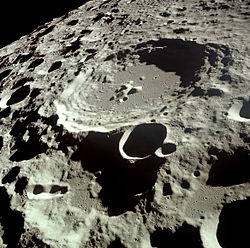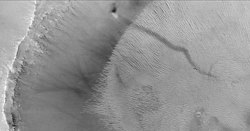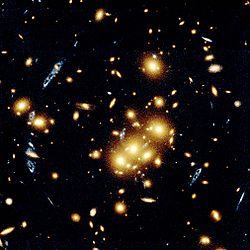Astronomi
|
|
Artikel ieu keur dikeureuyeuh, ditarjamahkeun tina basa Inggris. Bantuanna didagoan pikeun narjamahkeun. |
Astronomi, nu sacara étimologis hartina "hukum béntang" (tina Basa Yunani: αστρονομία = άστρον + νόμος) mangrupa élmu nu ngawengku panalungtikan jeung katerangan kajadian-kajadian nu tumiba di luareun Marcapada jeung atmosfirna. Astronomi ngulik sasakala, évolusi, sipat-sipat kimia jeung fisika objék-objék nu bisa kapanggih di langit (luareun Bumi), sarta prosés-prosés nu patali.

Astronomi mangrupa salah sahiji ti saeutik élmu ti mana para amatir bisa boga peran nu aktif, utamana dina manggihan jeung ngawaskeun fénoména transién. Astronomi euweuh patalina jeung astrologi, pseudoscience nu nyoba-nyoba ngaramalkeun takdir jalma ku jalan nyukcruk jalur objék astronomis. Sanajan dua widang éta babagi sumber nu méh sarua, ari sabenerna mah béda pisan; astronomer maké métode ilmiah, sedengkeun astrologer mah henteu.
Bagbagan astronomi[édit | édit sumber]
Dina mangsa munggaranana, balik deui ka jaman Yunani kuna jeung nu séjénna, astronomi utamana ngulik astrométri, ngalelebah planét jeung bintang di langit. Kadieunakeun, pagawéan Kepler jeung Newton geus naratas jalan pikeun celestial mechanics, nu sacara matematis ngaramal ketak/pola interaksi celestial bodies nu kapangaruhan ku graviti, jeung objék-objék tatasurya umumna. Pagawéan-pagawéan nu dikeureuyeuh dina dua widang ieu, nu baheula lolobana dipigawé ku leungeun, ayeuna mah geus maké alat-alat otomatis, nepi ka geus dianggap lain disiplin mandiri deui. Gerakan jeung posisi objék geus gampang pisan ditéang, astronomi modérn leuwih merhatikeun jeung ngusahakeun nengetan jeung neuleuman sipat fisik sabenerna objék-objék langit—what makes them "tick".
Ti mimiti abad ka-20 widang astronomi profésional beulah jadi observational astronomy jeung astrofisik tioritis. Najan astronomer lolobana ngagabungkeun unsur-unsur ti éta dua widang dina panalungtikanana, ku sabab bédana kaahlian nu dipaké, lolobana astronomer profésional leuwih condong ka salah sahijina. Observational astronomy leuwih condong utamana ka ngumpulkeun data, kaasup ngawangun jeung ngaropéa instrumén sarta ngolah data nu kakumpulkeun; cabang ieu ayeuna disebut salaku "astrométri" atawa "astronomy". Théoretical astrophysics is concerned mainly with figuring out the observational implications of different modéls, and involves working with computer or analytic modéls.
Widang ulikan astronomi ogé digolongkeun dumasar dua jalan nu béda: dumasar "subjék", biasana nurutkeun wewengkon langit (misalna Galactic astronomy) atawa "masalah nu ditujul" (saperti dibentukna béntang atawa kosmologi); atawa dumasar cara nu dipaké pikeun meunangkeun data.
Dumasar subjék atawa masalah nu ditujul[édit | édit sumber]

- Astrobiologi: the study of the advent and evolution of biological systems in the universe.
- Astrométri: the study of the position of objects in the sky and their changes of position. Defines the system of coordinates used and the kinematics of objects in our galaxy.
- Kosmologi: the study of the universe as a whole and its evolution.
- Galactic astronomy: the study of the structure and components of our galaxy and of other galaxies.
- Extragalactic astronomy: the study of objects (mainly galaxies) outside our galaxy.
- Galaxy formation and evolution: the study of the formation of the galaxies, and their evolution.
- Planetary Sciences: the study of the planets of the solar system.
- Stellar astronomy: the study of the stars.
- Stellar evolution: the study of the evolution of stars from their formation to their end as a stellar remnant.
- Star formation: the study of the condition and processes that led to the formation of stars in the interior of gas clouds, and the process of formation itself.
Also, there are other disciplines that may be considered part of astronomy:
See list of astronomical topics for a more exhaustive list of astronomy-related pages.
Cara-cara ngumpulkeun informasi[édit | édit sumber]
Dina élmu astronomi, informasi utamana mah ditarima ku jalan ngadétéksi jeung nganalisa radiasi éléktromagnétik, photons, tapi salian ti éta informasi ogé dibawa ku sinar kosmis, neutrinos, méteors, jeung, sakedap deui, gelombang gravitasi (tingal LIGO jeung LISA).
Pangbagian tradisional élmu astronomi nu ditangtukeun ku daérah spéktrum éléctromagnétik anu ditalungtik:
- Astronomi Optik ngagambarkeun téhnik anu dipaké ngadétéksi jeung nganalisa cahaya dina atawa sabudeureun panjang gelombang nu bisa kadétéksi ku panon (kira-kira 400 - 800 nm). Alat anu paling sering dipaké nyaéta téléskop, nu sok dilengkepan ku electronic imager jeung spectrograph.
- Astronomi Infrared nguruskeun détéksi radiasi infrared (panjang gelombang anu leuwih panjang batan cahaya beureum). Alat utama anu paling sering dipaké nyaéta téléskop tapi dilengkepan ku instrumen khusus pikeun infrared. Space telescope ogé dipaké pikeun ngaleungitkeun gangguan éléktromagnétik (electromagnetic interference) anu datang ti atmosfér.
- Astronomi Radio maké instrumen anu sama sakali béda pikeun ngadétéksi radiasi panjang gelombang antara mm nepi ka cm. Alat panarimana sarua jeung nu dipaké dina narima transmisi siaran radio. Tingal ogé Teleskop Radio.
- High-energy astronomy

Astronomi optik jeung radio bisa dilaksanakeun ngagunakeun observatorium anu aya di bumi, ku lantaran Atmosfer Bumi mah transparan ka panjang gelombang éta téh. Sedengkeun cahaya Infrared kaserep kuat pisan ku uap cai, ku lantaran kitu obsérvatorium infrared biasanya ditempatkeun di lokasi anu luhur, garing,atawa di luar angkasa.
Atmosfer téh opaque (teu bisa ditembus) pikeun panjang gelombang nu dipaké dina astronomi X-ray, astronomi gamma-ray, astronomi UV jeung, kacuali pikeun "jandéla" saeutik panjang gelombang, astronomi Far infrared, janten pangamatan ngan bisa dilaksanakeun ngagunakeun balon udara atawa observatorium ruang angkasa.
Sajarah ringkes[édit | édit sumber]
Dina bagian awal sajarahna, astronomi ngan wungkul ngawengku observasi jeung prédiksi ketak/gerak objék-objék langit nu bisa ditempo langsung ku panon.Rigveda didumasarkeun kana 27 konstélasi nu aya patalina jeung gerakan panonpoé jeung 12 babagian zodiak langit. Yunani Kuna méré sumbangan nu kalintang lobana pikeun astronomi, di antarana definisi sistim magnitude. The Bible contains a number of statements on the position of the éarth in the universe and the nature of the stars and planets, most of which are poetic rather than literal; see Biblical cosmology. In 500 AD, Aryabhata presented a mathematical system that took the éarth to spin on its axis and considered the motions of the planets with respect to the sun.
Astronomy was mostly stagnant in medieval Europe, but flourished méanwhile in the Arab world. The late 9th century Islamic astronomer al-Farghani (Abu'l-Abbas Ahmad ibn Muhammad ibn Kathir al-Farghani) wrote extensively on the motion of celestial bodies. His work was translated into Latin in the 12th century. In the late 10th century, a huge observatory was built néar Tehran, Iran, by the astronomer al-Khujandi who observed a series of meridian transits of the Sun, which allowed him to calculate the obliquity of the ecliptic. In Persia, Omar Khayyam (Ghiyath al-Din Abu'l-Fath Umar ibn Ibrahim al-Nisaburi al-Khayyami) compiled many tables and performed a reformation of the calendar that was more accurate than the Julian and came close to the Gregorian.
During the Renaissance Copernicus proposed a heliocentric model of the Solar System. His work was defended, expanded upon, and corrected by Galileo Galilei and Johannes Kepler. Kepler was the first to devise a system that described correctly the details of the motion of the planets with the Sun at the center. However, Kepler did not succeed in formulating a théory behind the laws he wrote down. It was left to Newton's invention of celestial dynamics and his law of gravitation to finally explain the motions of the planets.
Stars were found to be faraway objects. With the advent of spectroscopy it was proved that they were similar to our own sun, but with a wide range of temperatures, masses and sizes. The existence of our galaxy, the Milky Way, as a separate group of stars was only proven in the 20th century, along with the existence of "external" galaxies, and soon after, the expansion of the universe seen in the recession of most galaxies from us. Cosmology made huge advances during the 20th century, with the modél of the big bang héavily supported by the evidence provided by astronomy and physics, such as the cosmic microwave background radiation, Hubble's Law and cosmological abundances of elements.
Tempo ogé[édit | édit sumber]
- Ahli Astronomi jeung Astrofisik
- Astronomical naming conventions
- Daur
- space science...
- Timeline of black hole physics
- Timeline of cosmology
- Timeline of cosmic microwave background astronomy
- Timeline of other background radiation fields
- Timeline of galaxies, clusters of galaxies, and large scale structure
- Timeline of the interstellar medium and intergalactic medium
- Timeline of white dwarfs, neutron stars, and supernovae
- Timeline of stellar astronomy
- Timeline of solar astronomy
- Timeline of solar system astronomy
- Timeline of astronomical maps, catalogs, and surveys
- Timeline of telescopes, observatories, and observing technology
- Timeline of artificial satellites and space probes
- International Astronomical Union
- American Astronomical Society
- Royal Astronomical Society
- European Southern Observatory
- Lambang astronomis
Pakakas astronomi[édit | édit sumber]
Tumbu kaluar[édit | édit sumber]
Organisasi[édit | édit sumber]
- American Association of Variable Star Observers
- American Astronomical Society
- Astronomical Society of the Pacific
- Cassini Imaging Laboratory - Stunning images of the planets taken by the Cassini exploratory spacecraft
- Czech Astronomical Society
- Durham Region Astronomical Association
- Hawaiian Astronomical Society
- Herzberg Institute of Astrophysics Archived 2004-01-24 di Wayback Machine
- National Optical Astronomy Observatories Archived 1997-01-29 di Wayback Machine
- North York Astronomical Association Archived 2021-02-13 di Wayback Machine
- Open Encyclopedia Project - Astronomy Section.
- Royal Astronomical Society of Canada
- Royal Astronomical Society (UK)
- Royal Astronomical Society of New Zealand
- Saint Louis Astronomical Society
- Society for Popular Astronomy (UK)
Rujukan: Rumus jeung konstanta[édit | édit sumber]
- Astronomy Formulas
- Astronomical Constants Index
- Zombeck's Handbook of Space Astronomy and Astrophysics

